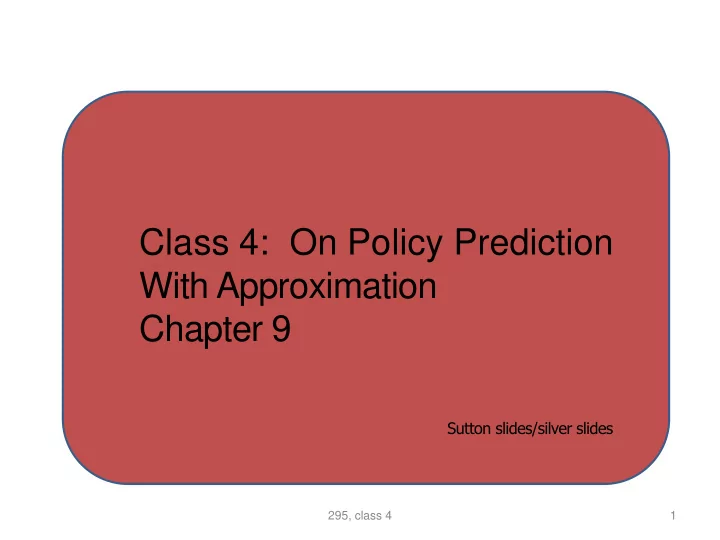

Class 4: On Policy Prediction With Approximation Chapter 9 Sutton slides/silver slides 295, class 4 1
Forms of approximations functions: • A linear approximation, • a neural network, • a decision tree 295, class 4 2
The Prediction Objective With approximation we can no longer hope to converge to the exact value for each state. We must specify a state weighting or distribution representing how much we care about the error in each state s. The objective function is to minimize the Mean Square Value Error, denoted: mu(s) is the fraction of time spent in s, which is called “on - policy distribution” The continuing case and the episodic case are different. • It is not obvious that the above is a good objective for RL (we want the value function in order to generate a good policy, but this is what we use. • For a general function form no guarantee to converge to optimal w* 17
Stochastic-gradient and Semi-gradient Methods 295, class 4 18
General Stochastic Gradient Descent 295, class 4 19
295, class 4 20
Gradient Monte Carlo Algorithm for estimating v we cannot perform the exact update (9.5) because v(S t ) is unknown, but we can approximate it by substituting U t in place of v(S t ). This yields the following general SGD method for state-value prediction: Th egeneral SGD (aiming at G_t) converges to a local optimum approximation 21
Semi Gradient Methods Replacing G_t with a bootstrapping target such as TD(0) or G_{t:t+n} will not guarantee convergence (but for linear functions) semi-gradient (bootstrapping) methods offer important advantages: they typically enable significantly faster learning, without waiting for the end of an episode. This enables them to be used on continuing problems and provides computational advantages. A prototypical semi-gradient method is semi-gradient TD(0), 295, class 4 22
State Aggregation 295, class 4 23
295, class 4 24
295, class 4 25
295, class 4 26
Linear Methods X(s) is a feature vector with the same dimensionality as w In the linear case there is only one optimum thus the Semi-SGD is guaranteed to converge to or near a local optimum. SGD does converges to the global optimum if alpha satisfies the usual conditions Of reducing over time. 27
TD(0) Convergence 295, class 4 28
Bootstrapping on the 1000-state random walk 295, class 4 29
295, class 4 31
n-Step Semi-gradient TD for v 295, class 4 32
Recommend
More recommend